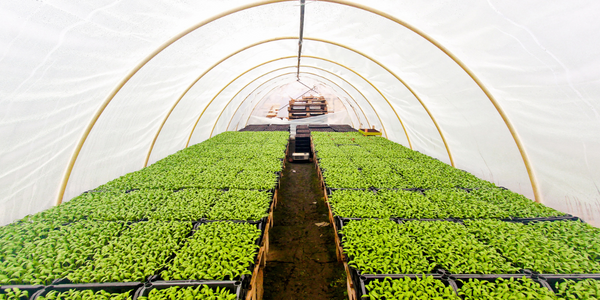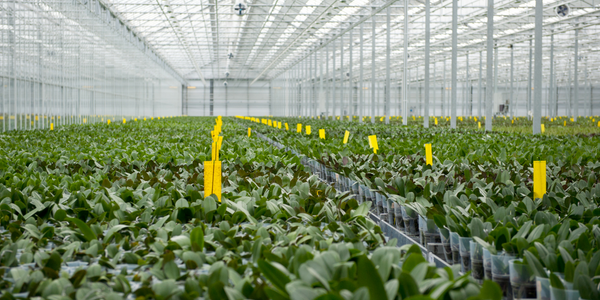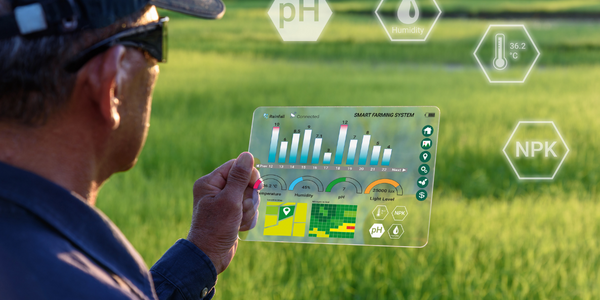下载PDF
Remote Monitoring and Controlling of Greenhouses

技术
- 自动化与控制 - 监督控制和数据采集 (SCADA)
- 传感器 - 相机/视频系统
- 传感器 - 湿度传感器
- 传感器 - 温度传感器
适用行业
- 农业
适用功能
- 流程制造
用例
- 智能灌溉
挑战
对于在大城市生活和工作的人来说,种植自己的水果和蔬菜是一个往往难以实现的梦想。但是租一个温室怎么样,可以通过网页远程播种、喷水和施肥,然后通过 IP 摄像机的流式视频观看农作物的生长情况,而您偶尔会在在周末或节假日收获和烹饪蔬菜?一群年轻的台湾企业家正在做自己的事情,并通过建立温室地块出租来实现其他人的梦想。利用 ADAM-6200 系列以太网 I/O 系列和 WebAccess 8.0 HMI/SCADA 软件提供的最新研华技术和功能,他们创建了温室自动化和远程监控解决方案,客户可以通过该解决方案控制和监控环境。计算机、智能手机或其他基于网络的设备上的实时虚拟仪表板。
客户
未公开
解决方案
客户将他们的温室分成更小的出租隔间,这意味着每个部分都需要一套独立的农业控制系统,包括传感器(用于温度、湿度、土壤 pH 等)、IP 摄像头、自动喷水器、风扇等. 他们需要 Advantech 提供的功能包括:继电器模块,可以远程控制喷水器和风扇等设备的执行器;数据采集模块,用于读取和传输传感器数据; HMI-SCADA软件,帮助实现远程监控和生成用户界面。系统实施:部署了大约 40 台研华 ADAM-6266 用于继电器控制,部署了近 20 台 ADAM-6217 用于读取和收集传感器数据。由于这些模块中的每一个都具有多个通道,因此它们中的每一个都能够监控多个隔间,每个隔间由不同的人同时操作。 ADAM-6200 集成了以太网交换机,可以在“菊花链”拓扑中相互连接,无需连接额外的以太网交换机。同时,由于这种拓扑结构,可以节省物理线路的费用。为了让他们的客户可以监控他们的花园的确切状态,我们的客户安装了最新版本的WebAccess HMI/SCADA软件,其中包含了研华的硬件监控和诊断固件/软件包SUSIAccess,以便他们可以远程监控CPU温度、风扇速度和其他硬件参数在简单和低成本的系统管理和维护中。由于 ADAM-6200 和 WebAccess 8.0 支持最新的 HTML5 网络语言和 RESTful 网页架构风格,我们的客户可以使用研华设计的 Widget Library 和 Dashboard Editor 轻松定制他们想要的跨平台仪表板页面,以显示动态数据在最终用户的设备(PC、iPad、智能手机等)上。部署的技术: ADAM-6217:8 通道隔离模拟输入 Modbus TCP 模块 ADAM-6266:4 通道继电器输出 Modbus TCP 模块,带 4 通道 DI 研华 WebAccess:基于浏览器的 HMI/SCADA 软件
相关案例.

Case Study
Intelligent Farming with ThingWorx Analytics
Z Farms was facing three challenges: costly irrigation systems with water as a limited resource, narrow optimal ranges of soil moisture for growth with difficult maintenance and farm operators could not simply turn on irrigation systems like a faucet.

Case Study
Greenhouse Intelligent Monitoring and Control Solution
Farming Orchids is the most successful form of precision farming in Taiwan, and also the most exported flower. Orchids need a specific temperature and humidity conditions to grow and bloom, and its flowering time may not be in line with market demands, so the price collapses when there is overproduction. Therefore, some farmers began to import automated greenhouse control systems for breeding and forcing, which not only improves quality, but also effectively controls the production period and yield to ensure revenue. In 2012, an orchid farmer built a Forcing Greenhouse of about 200 pings (approximately 661 Square Meters) in Tainan, Taiwan. The system integrator adopted Advantech’s APAX-5000 series programmable automation controllers to build the control platform, coupled with Advantech WebAccess HMI/SCADA software, to achieve cloud monitoring. The staff of the orchid field can monitor important data anytime via smart phone, iPad, and other handheld devices, and control the growth and flowering conditions. System requirements: In the past, most environmental control systems of orchid greenhouses in Taiwan used PLCs (Programmable Logic Controller) with poorscalability and control, and could not be connected to the Internet formonitoring from the cloud. For advanced database analysis and networking capability, the PC platform must be adopted. Therefore, PAC Systems (Programmable Automation Controller) with both PLC programming capabilities andPC functions is a better choice.The environmental control of the Orchid greenhouse switches on and off devices like fan, shade net, cooling/heat pump, liquid flow control, water-cooling wall etc. It is controlled by a control panel of electric controllers, and is driven by a motor, to adjust the greenhouse temperature, humidity, and other environmental conditions to the set parameters.

Case Study
Enabling Internet of Things Innovation in Agriculture
DigiBale, wanted to apply technology know-how and IP from implementations successfully to more agriculture sectors including cotton, forestry, sugarcane and cattle. However, farmers and growers still have worries about the connected technology.

Case Study
Precision beekeeping with wireless temperature monitoring
Honeybees are insects of large economic value and provide a vital service to agriculture by pollinating a variety of crops. In addition, bees provide us with valuable products such as honey, beeswax, propolis, bee venom, etc. Monitoring of honeybee colony health, population, productivity, and environmental conditions affecting the colony health have always been exceedingly difficult tasks in apiculture. Research has shown that even small deviations (by more than 2°C) from the optimal temperatures have a significant influence on the development of the brood and the health of adult bees.







